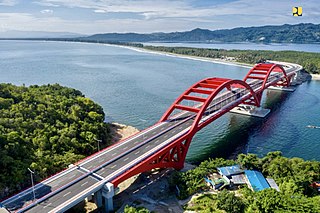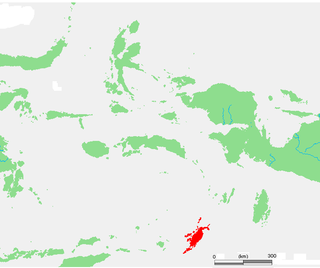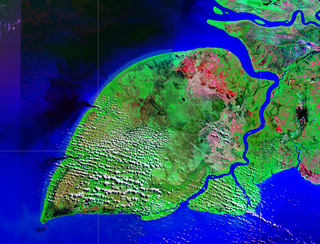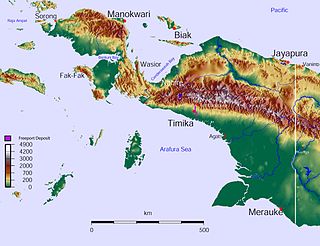
Dutch New Guinea or Netherlands New Guinea was the western half of the island of New Guinea that was a part of the Dutch East Indies until 1949, later an overseas territory of the Kingdom of the Netherlands from 1949 to 1962. It contained what are now Indonesia's six easternmost provinces, Central Papua, Highland Papua, Papua, South Papua, Southwest Papua, and West Papua, which were administered as a single province prior to 2003 under the name Irian Jaya, and now comprise the Papua region of the country.

Jayapura is the capital and largest city of the Indonesian province of Papua. It is situated on the northern coast of New Guinea island and covers an area of 940.0 km2 (362.9 sq mi). The city borders the Pacific Ocean and Yos Sudarso Bay to the north, the country of Papua New Guinea to the east, Keerom Regency to the south, and Jayapura Regency to the west.

The Battle of the Java Sea was a decisive naval battle of the Pacific campaign of World War II.

The Tanimbar Islands, also called Timur Laut, are a group of about 65 islands in the Maluku province of Indonesia. The largest and most central of the islands is Yamdena; others include Selaru to the southwest of Yamdena, Larat and Fordata to the northeast, Maru and Molu to the north, and Seira, Wuliaru, Selu, Wotap and Makasar to the west. The Indonesian phrase timur laut means "east of the sea" or "northeast".

Pulau Kolepom or Pulau Yos Sudarso is an island separated only by the narrow Muli Strait from the main island of New Guinea. It is part of the Merauke Regency, in the Indonesian province of South Papua. The island is leaf-shaped, about 165 km (103 mi) long with an area of 11,740 km2 (4,530 sq mi). It was known as Frederik Hendrik Island until 1963. Local and alternative names of the island include Dolok and Kimaam.

Commodore Yosaphat "Yos" Sudarso was an Indonesian naval officer killed at the Battle of Arafura Sea. At the time of his death, Yos Sudarso was deputy chief of staff of the Indonesian Navy and in charge of an action to infiltrate Dutch New Guinea. He was promoted to vice admiral posthumously.

The Indonesian Navy is the naval branch of the Indonesian National Armed Forces. It was founded on 10 September 1945 and has a role to patrol Indonesia's lengthy coastline, to enforce and patrol the territorial waters and Exclusive Economic Zone (EEZ) of Indonesia, to protect Indonesia's maritime strategic interests, to protect the islands surrounding Indonesia, and to defend against seaborne threats.

The Digul River is a major river in South Papua province, Indonesia, on the island of New Guinea. It is the fourth longest river in New Guinea after the Sepik River, Mamberamo River, and Fly River. With a total length of 853 km (530 mi) and a drainage basin of 45,900 km2 (17,700 sq mi).

Guided Democracy was the political system in place in Indonesia from 1959 until the New Order began in 1966. It was the brainchild of President Sukarno, and was an attempt to bring about political stability. Sukarno believed that the parliamentarian system implemented during the liberal democracy period in Indonesia was ineffective due to its divisive political situation at that time. Instead, he sought a system based on the traditional village system of discussion and consensus, which occurred under the guidance of village elders. With the declaration of martial law and the introduction of this system, Indonesia returned to the presidential system and Sukarno became the head of government again.

Geologically, the Sahul Shelf is a part of the continental shelf of the Australian continent, lying off the northwest coast of mainland Australia.

Yos Sudarso Bay, known as Humboldt Bay from 1827 to 1968, is a small bay on the north coast of New Guinea, about 50 kilometers west of the border between Indonesia's province of Papua and the country of Papua New Guinea. The Indonesian provincial capital Jayapura is situated on the bay.

HMS Scourge was an S-class destroyer built for the Royal Navy during the Second World War. The ship was sold to the Netherlands postwar, where it saw action in the Korean War and the West New Guinea dispute.

Operation Trikora was a combined Soviet-Indonesian military operation which aimed to seize and annex the Dutch overseas territory of Netherlands New Guinea in 1961 and 1962. After negotiations, the Netherlands signed the New York Agreement with Indonesia on 15 August 1962, relinquishing control of Western New Guinea to the United Nations.

The West New Guinea dispute (1950–1962), also known as the West Irian dispute, was a diplomatic and political conflict between the Netherlands and Indonesia over the territory of Dutch New Guinea. While the Netherlands had ceded sovereignty over most of the Dutch East Indies to Indonesia on 27 December 1949 following an independence struggle, it retained control over its colony on the western half of New Guinea. The Indonesian government claimed this territory as well, on the basis that it had belonged to the Dutch East Indies and that the new Republic of Indonesia was the legitimate successor to the former Dutch colony.

HNLMS Utrecht (D817) was a destroyer of the Friesland class. The ship was in service with the Royal Netherlands Navy from 1957 to 1980. The destroyer was named after the Dutch province of Utrecht and was the eighteenth ship with this name. In 1980 the ship was taken out of service and sold to Peru where it was renamed Castilla. The ship's radio call sign was "PAEY".

HNLMS Van Galen (F803) was a frigate of the Van Speijk class. The ship was in service with the Royal Netherlands Navy from 1967 to 1987. The ship's radio call sign was "PAVB". She was sold to the Indonesian Navy where the ship was renamed KRI Yos Sudarso (353).

HNLMS Evertsen (F815) was a frigate of the Van Speijk class. The ship was in service with the Royal Netherlands Navy from 1967 to 1989. The ship's radio call sign was "PAVG". She was sold to the Indonesian Navy where the ship was renamed KRI Abdul Halim Perdanakusuma (355).

Air Chief Marshal (Ret.) Elang Soerjadi Soerjadarma was the Commander of the Indonesian National Armed Forces from 1959 to 1962 and the Chief of Staff of the Indonesian Air Force from 1946 to 1962.
The supertramp fantail is a species of bird in the family Rhipiduridae that is found on the Lesser Sunda Islands, Maluku Islands, Kai Islands and Aru Islands. It was formerly considered to be subspecies of the Arafura fantail. Its natural habitat is subtropical or tropical moist lowland forests.



















